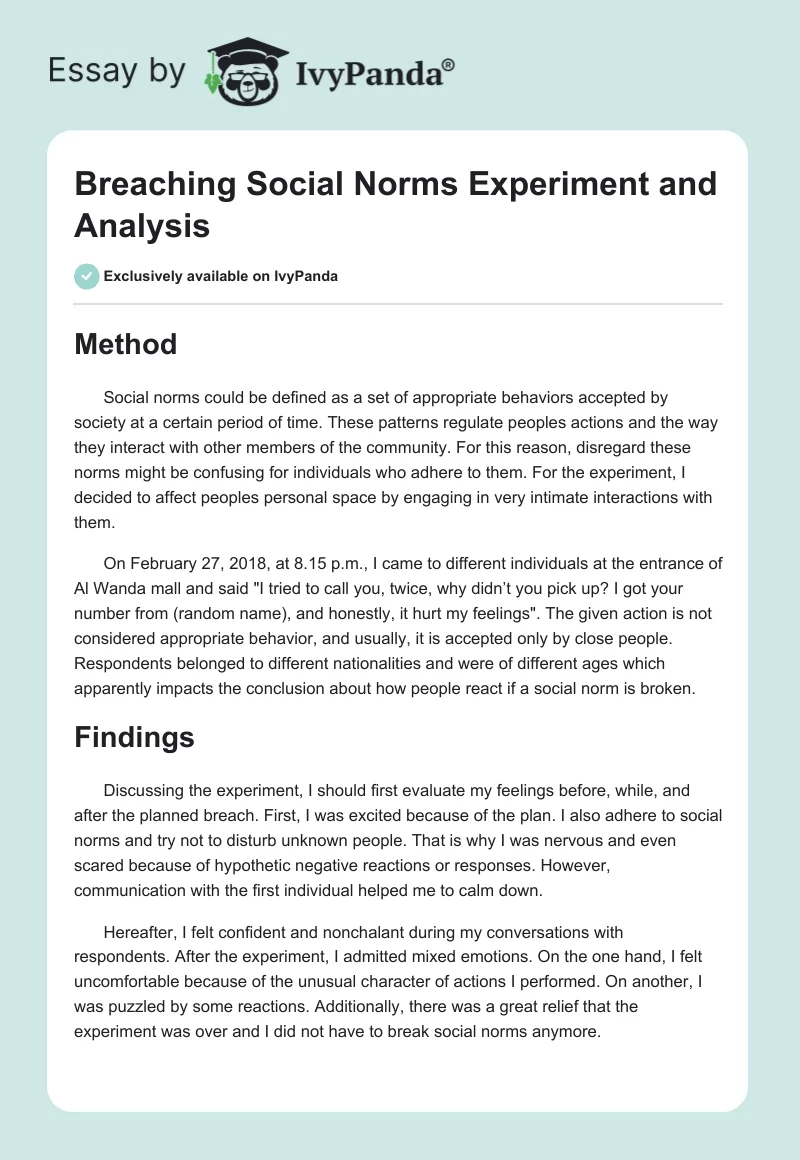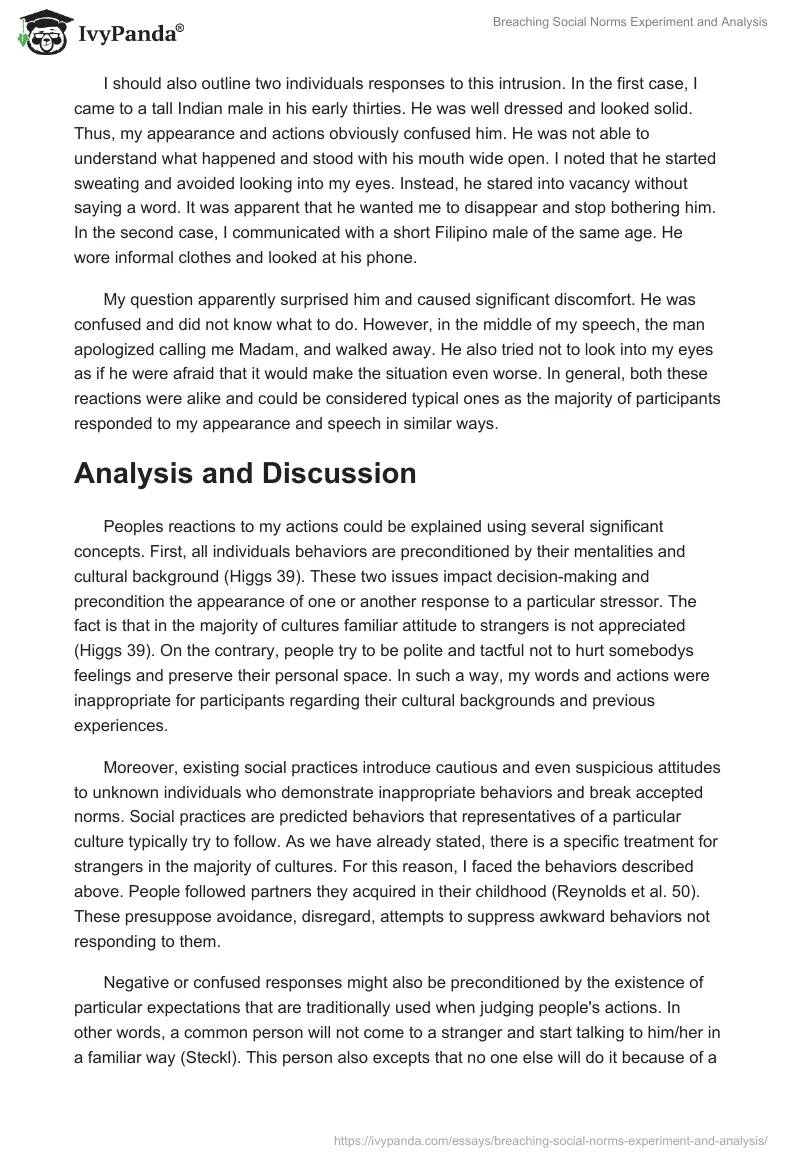Method
Social norms could be defined as a set of appropriate behaviors accepted by society at a certain period of time. These patterns regulate peoples actions and the way they interact with other members of the community. For this reason, disregard these norms might be confusing for individuals who adhere to them. For the experiment, I decided to affect peoples personal space by engaging in very intimate interactions with them.
On February 27, 2018, at 8.15 p.m., I came to different individuals at the entrance of Al Wanda mall and said “I tried to call you, twice, why didn’t you pick up? I got your number from (random name), and honestly, it hurt my feelings”. The given action is not considered appropriate behavior, and usually, it is accepted only by close people. Respondents belonged to different nationalities and were of different ages which apparently impacts the conclusion about how people react if a social norm is broken.
Findings
Discussing the experiment, I should first evaluate my feelings before, while, and after the planned breach. First, I was excited because of the plan. I also adhere to social norms and try not to disturb unknown people. That is why I was nervous and even scared because of hypothetic negative reactions or responses. However, communication with the first individual helped me to calm down.
Hereafter, I felt confident and nonchalant during my conversations with respondents. After the experiment, I admitted mixed emotions. On the one hand, I felt uncomfortable because of the unusual character of actions I performed. On another, I was puzzled by some reactions. Additionally, there was a great relief that the experiment was over and I did not have to break social norms anymore.
I should also outline two individuals responses to this intrusion. In the first case, I came to a tall Indian male in his early thirties. He was well dressed and looked solid. Thus, my appearance and actions obviously confused him. He was not able to understand what happened and stood with his mouth wide open. I noted that he started sweating and avoided looking into my eyes. Instead, he stared into vacancy without saying a word. It was apparent that he wanted me to disappear and stop bothering him. In the second case, I communicated with a short Filipino male of the same age. He wore informal clothes and looked at his phone.
My question apparently surprised him and caused significant discomfort. He was confused and did not know what to do. However, in the middle of my speech, the man apologized calling me Madam, and walked away. He also tried not to look into my eyes as if he were afraid that it would make the situation even worse. In general, both these reactions were alike and could be considered typical ones as the majority of participants responded to my appearance and speech in similar ways.
Analysis and Discussion
Peoples reactions to my actions could be explained using several significant concepts. First, all individuals behaviors are preconditioned by their mentalities and cultural background (Higgs 39). These two issues impact decision-making and precondition the appearance of one or another response to a particular stressor. The fact is that in the majority of cultures familiar attitude to strangers is not appreciated (Higgs 39). On the contrary, people try to be polite and tactful not to hurt somebodys feelings and preserve their personal space. In such a way, my words and actions were inappropriate for participants regarding their cultural backgrounds and previous experiences.
Moreover, existing social practices introduce cautious and even suspicious attitudes to unknown individuals who demonstrate inappropriate behaviors and break accepted norms. Social practices are predicted behaviors that representatives of a particular culture typically try to follow. As we have already stated, there is a specific treatment for strangers in the majority of cultures. For this reason, I faced the behaviors described above. People followed partners they acquired in their childhood (Reynolds et al. 50). These presuppose avoidance, disregard, attempts to suppress awkward behaviors not responding to them.
Negative or confused responses might also be preconditioned by the existence of particular expectations that are traditionally used when judging people’s actions. In other words, a common person will not come to a stranger and start talking to him/her in a familiar way (Steckl). This person also excepts that no one else will do it because of a particular social norm that exists in society. In this regard, the majority of participants were confused because of the discrepancy between their expectations and reality.
Therefore, there are specific interpersonal communication patterns that are established in different cultures and determine the choice of words, verbal and non-verbal communication patterns to align an efficient face-to-face communication not hurting someones feelings (Baum 54). These depend on culture, age, mentality, experience, etc. (Baum 54). However, the majority of people asked by me had a similar cultural background which condemns breach of social norms and interference into the private space. For this reason, their reactions were quite predictable. They did not try to keep the conversation, on the contrary, people wanted to escape and forget about this very situation.
I should also say that there were some differences in verbal and non-verbal responses. Some individuals kept silent and stood still pretending that they do not hear me whereas others excused and tried to leave. These divergences are stipulated by the diverse experiences and beliefs of individuals who participated in the experiment. The fact is that the set of values an individual has shaped the way he/she behaves and communicates in multiple situations (Henrich 78). These factors also precondition the manner a person acts in stressful occurrences that imply the breach of social norms. That is why some individuals preferred to ignore me while others just left.
Conclusion
Finally, I admitted that some people (especially Filipinos) evaluated my status and actions regarding my nationality. This fact also stipulated their behaviors. In such cases, they called me Madam and demonstrated high respect. At the same time, they tried to leave quietly as if their emotional response would be considered misconduct and result in some negative circumstances. Additionally, individuals treated me as if I were of a higher authority and had some power to impact their lives.
This example perfectly demonstrates the significant impact culture and mentality have on our actions and behaviors (Mlodinow 23). Having a stereotypical image of an Emirati and associating this individual with high authority, power, and wealth, people tried to behave in a way that would not make me angry and leave.
In general, the experiment shows that the breach of social norms is confusing for people who have specific behavioral patterns and use them to interact with other members of society. Additionally, the cultural background preconditions individuals actions and the way they respond. My attempts to extravagate and trigger specific reactions prove it.
Works Cited
Baum, William. Understanding Behaviorism: Behavior, Culture, and Evolution. Wiley-Blackwell, 2017.
Henrich, Joseph. The Secret of Our Success: How Culture Is Driving Human Evolution, Domesticating Our Species, and Making Us Smarter. Princeton University Press, 2017.
Higgs, Suzanne. “Social norms and their influence on eating behaviours.” Appetite, vol. 86, 2015, pp. 38-44. Web.
Mlodinow, Leonard. Subliminal: How Your Unconscious Mind Rules Your Behavior. Vintage, 2013.
Reynolds, Katherine, Emina Subasic, and Karen Tindall. “The Problem of Behaviour Change: From Social Norms to an Ingroup Focus.” Social and Personality Psychology Compass, vol. 9, no. 1, 2015, pp. 45-56. Web.
Steckl, Carrie. “How Social Norms Affect Our Decisions.” MentalHelp.net. 2013. Web.


